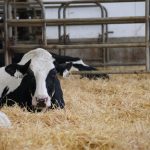Dairy Dispatch
Manure Gas Killed a Father and His Two Sons in Minutes. A $200 Monitor Could Have Stopped It.
A father. Two sons. Four coworkers. All dead from manure gas in minutes. The monitor that could have saved them? $200. Why does this keep happening? E […]The Triple Cushion Trap: Why 2025’s Strong Margins Won’t Save You in 2026
Three things propping up your dairy. All temporary. The window to reposition closes in weeks, not months. Executive Summary: Three temporary forc […]Your Fresh Cow Problems Started 6 Weeks Ago: The $70K Dry Period Fix
Metritis Day 5 = Dry pen Day -45. Elite dairies know this. Average dairies pay $70K/year, learning it the hard way. Which are you? Executive Summary:& […]The Hay Bale That Changed Washington: Farmers’ 6-Year Whole Milk Crusade Ends in Unanimous Victory
They told him he was wasting his time. A dairy farmer painting hay bales? That's not how you change federal policy. Washington doesn't listen to guys […]The Week Every Dairy Market Crashed Together- and Why Record Exports Couldn’t Stop It
Dec 15: Germany's butter -9.3%. Chicago cheese at 18-month low. NZ powder is falling. Every dairy market crashed the same week—despite record exports. […]
Top News from the Past Week
- The Man Who Made Sure 11,500 Dairy Farms Had Somewhere to Ship Their Milk Gary Hanman built more than a cooperative. He built a promise that no matter how dark things got, someone would always come for the milk. I've written about dairy farmers…
- Wisconsin’s First H5N1 Case: The 5-Day Spread No One Sees Coming—And How to Catch It Wisconsin's first H5N1 case: healthy cow, full production, zero symptoms. Virus has already been spreading for 5 days. What farms with better outcomes did differently—and when they did it. EXECUTIVE…
- Ferrari Genetics, Go-Kart Support: Why 30,000-Pound Cows Are Gone by Lactation Three Today's dairy cows have more genetic potential than any generation before them. And yet we're dropping race-car engines into go-karts and acting surprised when the wheels start coming off. Your…
- Dairy’s National Average Is a Lie: Texas +50,000 Cows, Washington -21,000 – Your 90-Day Plan Here's the thing about national averages—they can hide more than they reveal. While USDA reports 3%+ growth, one state added 50,000 cows and another lost 21,000. Let me walk you…
- Don’t Send That Kid Back”: Three Dairy Careers That Nearly Died on Day One Don't send that kid back." One phone call nearly killed Brian Coyne's career before it started. He's now Manager of Applied Genetic Strategies at Select Sires. Executive Summary: Don't send that…
More News
- The Man Who Made Sure 11,500 Dairy Farms Had Somewhere to Ship Their Milk
- Weekly Global Dairy Market Recap Dec 15th, 2025: The “Wall of Milk” vs. The Heifer Shortage (Why 2025 is Different)
- Wisconsin’s First H5N1 Case: The 5-Day Spread No One Sees Coming—And How to Catch It
- USDA’s $700M Regenerative Push: What the 90% Cost-Share Won’t Tell Dairy Farmers
- Electric Dairy Tractors: Monarch Now, Deere Later, or Neither?
Feature Articles
Trembling Hands, A Decade of Faith, 200 Fewer Cows: Three Paths to the Same Truth
Trembling hands at Expo. A decade of faith. 200 fewer cows. Three families. One truth about what excellence really costs. E44 […]She Won’t Win Shows, But She Pays the Bills: The Rise of the $3,000 ‘System Cow.’
The 'System Cow' won't win a banner. But she might save you US$180,000 a year. E442 She Won’t Win Shows, But She Pays the Bil […]The 18-Month Window: Why Your Lender Knows Your Dairy’s in Trouble Before You Do
The math says 2,800 dairies will close this year. Your lender already knows if you're one of them. Do you? E441 The 18-Month […]Four Bets. Five Legends: The Holstein Visionaries Who Built Everything You’re Breeding Today
Four breeders made four impossible bets. Every Holstein alive today is the payoff. Here's what they knew that we forgot. E340 […]2025 Dairy Year in Review: Ten Forces That Redefined Who’s Positioned to Thrive Through 2028
Everyone's celebrating 2025's wins. Almost nobody's asking how heifer shortage, processor overcapacity, and component changes […]
Popular Articles from the Past 30 Days
- They Called Him the Three-Legged Bull. He Created the Modern Red Holstein: The Untold Story of Hanover-Hill Triple Threat-Red 53 years ago, a man bet his career on a red calf everyone else called a defect. He was right E433 They Called Him the Three-Legged Bull. He Cre |…
- Four Bets. Five Legends: The Holstein Visionaries Who Built Everything You’re Breeding Today Four breeders made four impossible bets. Every Holstein alive today is the payoff. Here's what they knew that we forgot. E340 Four Bets. Five Legends: The Holstein Vision | RSS.com…
- The $640 Question: Why Some Dairy Farmers Are Rethinking Everything They Know About Dry-Off Wisconsin trial: 47% fewer deaths, 70% less leakage, $640 more per cow. The dry-off method? Backwards from everything you know. E421 The $640 Question: Why Some Dairy Farmers Are |…
- The Robot Truth: 86% Satisfaction, 28% Profitability – Who’s Really Winning? When satisfaction rates soar but profitability plummets, the dairy industry's automation revolution reveals uncomfortable truths about who really wins The Robot Paradox reveals dairy farming's uncomfortable truth: while 86% of…
- The Woman Who Milks Other People’s Dreams: Michele Schroeder’s Unexpected Path from Historic Dairy Legacy to Relief Milking Pioneer Meet the Minnesota dairy farmer who sold her cows but kept her calling—and why her story matters more than you think for the industry's future. E436 The Woman Who Milks…
More Articles
- The 2025 Gift Guide Built on Four Hard Questions
- Colostrum. Lameness. Beef Sires. The December 2025 Journal of Dairy Science Just Changed All Three.
- The Woman Who Milks Other People’s Dreams: Michele Schroeder’s Unexpected Path from Historic Dairy Legacy to Relief Milking Pioneer
- The $775-Per-Cow Secret: Why This California Dairy’s Hospital Pen Stays Empty
- China Promised 100%. Delivered 2.7%. Here’s Your 48-Hour Defense Plan.
The Bullvine LLC © 2025 | Terms of Use | Community Guidelines | Privacy Policy |
Functional Always active
Preferences
Statistics
Marketing
To provide the best experiences, we and our partners use technologies like cookies to store and/or access device information. Consenting to these technologies will allow us and our partners to process personal data such as browsing behavior or unique IDs on this site and show (non-) personalized ads. Not consenting or withdrawing consent, may adversely affect certain features and functions.
Click below to consent to the above or make granular choices. Your choices will be applied to this site only. You can change your settings at any time, including withdrawing your consent, by using the toggles on the Cookie Policy, or by clicking on the manage consent button at the bottom of the screen.
















